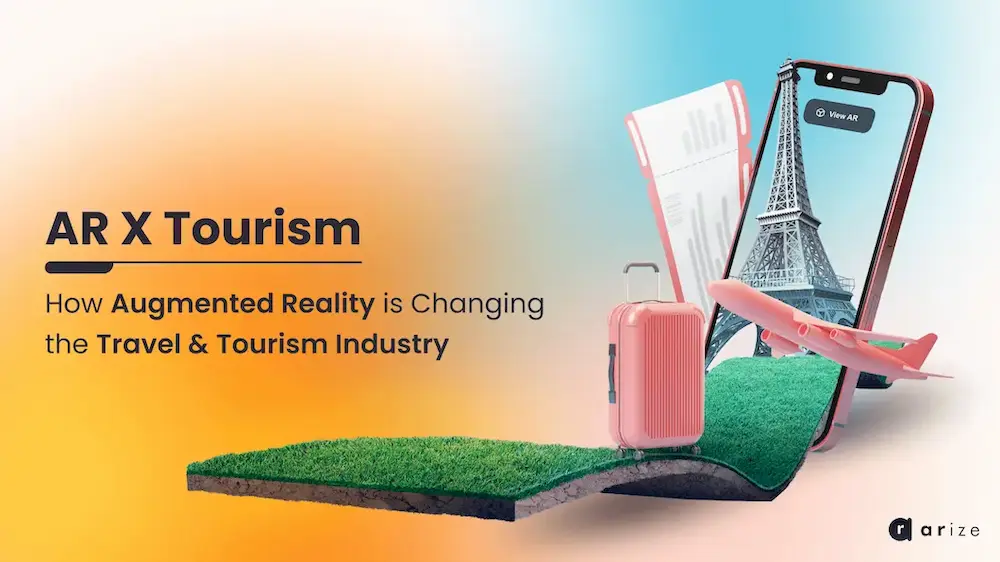Augmented reality transforms every facet of our everyday lives as technology grows and solves daily challenges. The advent of AR has also opened doors for multiple industries to enhance and enrich the experience they provide for their customers. These industries are grabbing the opportunity with both hands. According to research, the augmented reality market is predicted to grow from $5.91 billion to $198 billion by 2025. One industry that is reaping the benefits of AR technology is travel and tourism. AR plays a crucial role in transforming the tourism landscape and making travel experiences richer for tourists.
Smartphones, easy access to the internet, and geolocation are the three main factors responsible for this transformation. Still, we must also factor in the changes in tourists’ mentality, behavior, and consumption habits.
Simply put, augmented reality enhances the traveler experience, making it more accurate and immersive, giving birth to a new, much-improved way to experience travel and intelligent tourism.
Smart Tourism
Smart tourism is linked to the ideas of the smart city. This city relies on information and communication technologies to create and build its citizens’ infrastructures. It utilizes a combination of people, technology, and creativity to make it more efficient, offering its inhabitants more value.
It has become an intelligent tourist destination where they can experience smart tourism. An innovative destination offers a more immersive and interactive visiting experience that improves the quality of their stay.
This is where the objective of AR applied to tourism comes into play. To manage resources and build a place that meets the needs of travelers, tourists (as well as residents). More and more cities are becoming destinations offering smart tourism to a traveler whose profile is that of individuals with all the devices and knowledge of the technology necessary to enjoy a 360 experience and make the most of their trip.
This is precisely the ideal profile for augmented reality. A technological and digital tourist who wants to visit the destination, make the most of their trip, and get a fully immersive and interactive experience.
In this context, AR offers endless possibilities and activities, from information about the place. Its monuments and buildings, gastronomic and cultural itineraries, museums, schedules, or transport information, among other options.
Here are a few of the possibilities we can already experience
Smartphone Navigation
Have you ever been lost in another country? Can’t understand the street signs? We’ve all experienced it, but with AR technology, you can navigate safely to your destination without relying on luck or the kindness of locals.
The most obvious example of this is Google Maps. This app incorporates AR in many ways, including its Street View feature. Once activated, this will let you view the roads you are walking on and directs you with virtual arrows and pointers.
Your Guide
If you want to explore exciting places, a tour with a knowledgeable tour guide is a great way to get the whole experience. But what if you’re working on a tight budget or want to explore at your own pace?
Nowadays, you can have your tour guide powered by AR experiences. Using your smartphone, you can identify landmarks and buildings and provide insightful descriptions of places of interest.
For instance, the app City Tour uses object recognition to display information regarding museums, galleries, and other places of interest on your screen. Florence in Italy has an app that guides you as you travel through the city, allowing you to explore at your own pace.
Rebuild Historical Monuments
Historical landmarks are the highlight of any trip. Seeing buildings and monuments that have stood the test of time is awe-inspiring.
But we also know some landmarks worldwide are no longer in their original state or are even eradicated, with only a few ruins remaining. While we can see the remnants, it’s challenging to experience them in all their glory.
Now AR experiences can rebuild them when it is not possible in the real world. In South Korea, they tried reconstructing the Donuimun Gate, one of the Four Great Gates in the City Wall of Seoul. Unfortunately, the cost and disruption meant it would not be possible.
They rebuilt it virtually through the Cheil Worldwide app. Using this mobile app. They can view the cultural site and its state during different periods, giving tourists long-forgotten world views.
Museums and More
As with AR tours or digital guides, when visiting a museum, the visit can be more dynamic and, above all, more accurate and complete, all thanks to AR.
An increasing number of museums with augmented reality allow tourists to enjoy a guided and interactive tour with the bonus of not having to book a specific time and without having to depend on a guide or a group, allowing you to have the experience when you want.
Augmented reality in museum environments also offers the possibility of accessing more complete and entertaining information about each piece in the museum, as well as recreating the history of each one of them.
Crucial for the Future
The importance of augmented reality in the travel industry can’t be stressed enough. AR can open doors and provide enormous potential to the point that it can help you discover completely new business opportunities. The travel industry is based on selling experiences, and AR solves an array of pain points and enhances any travel experience you can offer. AR can expand the customer base of hotels, booking services, local restaurants, and all other stakeholders in the industry.



